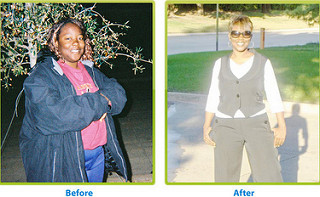How to Get Rid of Back Fat
The back is one of the hardest places to tone and decrease body fat when you're trying to lose weight. Unfortunately, it's not possible to "spot treat" any part of your body.[1] Your diet and exercise regimen has to support both toning your upper body and decreasing overall body fat. You can't just lose weight in one small, particular area of your body. It's more effective to have a combination of diet and exercise to help tone up your entire back and decrease your overall body fat. Making small modifications to your diet and performing the right type of cardio and strength training can help you get rid of back fat.
Steps
Method 1 Exercising to Reduce Back Fat
-
1
Step up the cardio. For best results, exercise for at least 30 minutes at a time, three to five days a week.[2]
- These cardio activities are particularly effective for getting rid of back fat. They will burn calories and strengthen your back muscles: Rowing, boxing and swimming.
- Other cardio exercises to include are: running/jogging, walking, biking, using the elliptical or dancing.
- The benefits of cardio don't just stop at toning your back. Cardio has also been shown to reduce the risk of heart disease, improve cholesterol and triglyceride levels, improve heart function, and reduce the risk of osteoporosis.[3]
- You cannot "spot treat" or lose weight in only one particular area. You need to lower your overall body weight and decrease body fat to see a reduction in one particular area. Cardio exercises will help support this.
-
2
Try interval training. This is a way to burn fat more quickly. It will not only tone your back, but tone and trim fat from all over your body. [4]
- Doing higher intensity interval training can help burn more fat and increase your fat burn after you've completed the exercise.[5]
- One way to do interval training is by running: Run at a vigorous pace for several minutes, return to a more comfortable pace for five minutes, then speed up your routine for another two minutes. Continue your entire routine in this manner for 15–20 minutes.
- Consider High Intensity Interval Training. The NIH defines HIIT as exercising at a high intensity for 30 seconds to several minutes with bouts of either no or low intensity exercise for a minute or two in between. Doing this actually amplifies the benefits seen in doing normal cardio exercises. It can improve your cardiovascular health and raise your metabolism.[6] When exercising at high intensity, you should be perspiring and breathless enough that you cannot speak phrases or have a conversation.
- Do HIIT training for 20 minutes, with an additional five minute warm-up and cool-down.
-
3
Do bodyweight exercises. There are some specific exercises you can do to strengthen your back that don’t require special machines. Many of these exercises can even be done at home.
- Tie a resistance band to a doorknob. Shut the door and stand about 2 feet away from the door. Hold the ends of the resistance band in each hand and bend your elbows 90 degrees. Pull your arms back so that your shoulders are pushing together. Hold this position for 10 seconds and then release. Repeat the motion seven to 10 times. If you don’t feel enough resistance, move a little further away from the door or use a thicker resistance band.
- Lower back extensions target the lower back and should help with that annoying fat that hangs over the top of your jeans. To get started, lie flat on the floor, on your stomach. Place your hands behind your head and lift your chest and legs as far off the ground as you can. Three sets of 10 is a good place to start.
- With bridge exercises, lie on the floor on your back. Bend your knees at a 90-degree angle, but keep your feet flat on the floor. Lift your buttocks up until your back makes a straight line-like a bridge. Hold it there for 10 to 15 seconds and then slowly lower your body back to the floor. Do this 10 to 20 times. [7].
- Use the plank exercise to help tone your entire back and core. Place your forearms on the floor. Hold your body in a straight line. Hold this plank position for as long you can. Rest and repeat one to two more times.
-
4
Exercise With Weights and Machines. Using free weights or weight machines can also help tone your back. Combined with cardio and other strength training exercises, you can tone your back muscles easily.
- Start with weights you are comfortable with. You should be able to lift them without too much strain. If you can lift the dumbbells with no strain whatsoever, you will not work your muscles.
- Bent-over flys will help tone your upper back. Hold a dumbbell in each hand and bend over at your hips. Lift your arms out to the sides, like airplane wings, until they are at shoulder height and then lower them to your sides. Do three sets of eight repetitions each. As you improve the strength of your muscles and connective tissues and perfect the movement, increase the weight and the number of sets to build muscle. If you just want to tone, increase the number of repetitions.
- For a Lat pull down, grab the cable bar, gripping it wide and in an overhand position. Position your thighs beneath the support and place your knuckles facing upwards. When you stretch up, the bar should be just within your reach. If it's not, adjust the height. Pull the bar down to your chin (all the while keeping your back straight) in one fluid movement, feeling your shoulder blades coming together. Slowly release the bar to its original height and repeat.
- Do shoulder presses. Take two dumbbells, one in each hand. Hold dumbbells by your ears, palms facing forward. Press your hands straight above your head until your arms are fully extended. Lower back down slowly until your hands are again by your ears. Repeat one to three sets or as many as you’re able. These will develop your shoulders; deltoids that are well-developed can help the back look broader and the waist appear smaller.
- Do bent-over rows. Place a dumbbell in each hand. Bend slightly at the waist – about 45 degrees. Extend arms straight in front of your, palms facing inwards towards each other. Pull arms back until your upper arms are next to your back. Release your arms slowly back to their fully extended position. Repeat one to three sets or as many as you’re able.
-
5
Meet with a personal trainer. If you’re just starting out with exercise or want more specific help, working with a personal trainer may be beneficial. They may be able to guide you towards reducing back fat and toning your back muscles.
- Personal trainers are fitness professionals that have a wide variety of experience with exercises. Meet with someone and ask about what exercises you can do to help tone your back and reduce your overall body fat.
- Many gyms offer a free trial of a personal training session when you sign up. They will most likely offer personal training sessions for a cost at a variety of times.
- You may also be able to find personal trainers who have blogs or videos online that can give you more detailed information as well.
Method 2 Changing Your Diet
-
1
Cut your daily calorie intake. If you cut out 500 calories a day and exercise regularly, you will lose about a pound every week.[8] This will also help you reduce your back fat.
- Use a food diary or online food tracker to help you cut out 500 calories daily.
- These food trackers in addition to online calculators can give you an estimated total daily caloric intake to help you lose weight. Everyone's needs will be different, so using a calculator can help give you a more specific calorie range.
- Do not cut out too many calories. This can slow weight loss, lead to nutrient deficiencies or make you feel tired and fatigued. In general, health professionals recommend to eat a minimum of 1,200 calories daily.[9]
- Cutting calories will help you lose weight, but without the cardio and back strengthening exercises, your back muscles will not get toned. It’s important to include both diet and exercise to get your desired result.
-
2
Eat a balanced diet. Even if you’re cutting calories to help reduce back fat, it’s still important to eat a balanced diet.
- Including a variety of foods from each food group will help you consume an adequate amount of nutrients each day. When you have a poor quality, unbalanced diet, this may work against your weight loss goals.[10]
- Include protein at each meal. Protein is an essential nutrient in your diet. Foods like poultry, eggs, dairy, legumes, seafood or tofu provide adequate protein to your diet. Aim for a 3-4 oz (21-28g) portion at all meals.[11]
- Eat a variety of fruits and vegetables each day. These foods are low calorie and nutrient dense making them great foods for a low-calorie diet. Try making ½ your plate a fruit or vegetable to help support your weight loss.
- Lastly, it’s important to include healthy sources of grains like bread, rice or pasta. Grains provide fiber and a variety of B vitamins important to your health. If you can, choose 100% whole grains for more nutrients.[12]
-
3
Fill up on satisfying foods to cut down on hunger levels. When you're trying to lose weight and cut calories, managing hunger can be an issue. It's hard to stick to a diet plan, if you're feeling hungry often.
- Combining certain types of foods and including the right types of foods at each meal and snack can help you stay satisfied longer after meals and decrease your overall hunger level.
- Healthy fats are a great addition to a weight loss diet. Fat takes longer to digest compared to foods rich in carbohydrates and helps keep you satisfied longer. Include one to two servings of heart healthy fats every day. Try: olive oil, avocado, nuts or nut butters, flax seeds, olives, salmon, tuna, sardines or mackerel.
- In addition to healthy fats, the combination of protein and complex carbohydrates helps you stay satisfied longer as well. Choose lean proteins or proteins with healthy fats like: seafood, poultry, beef, pork, low-fat dairy, legumes or tofu. Pair these with fiber-rich complex carbs like: starchy vegetables, fruits, legumes, nuts and whole grains.
-
4
Eliminate high-calorie drinks. So often we forget about the liquid calories we consume. Replace the sodas and juices with water and hydrating, no-calorie beverages.
- Drink adequate amounts of fluids like water, decaf coffee, decaf tea or flavored water to stay hydrated. Everyone requires different amounts of fluids, but aiming for 1.5-3 liters each day is a good place to start.
- Studies show that drinking high calorie beverages can promote weight gain[13]. Liquids do not necessarily make you feel full and most people will not count their liquid calories into their total daily intake.
- Although switching from regular soda to diet soda may save you calories in the short term, it's not yet clear if it's effective for preventing obesity and related health problems[14].
-
5
Limit treats and indulgences. Part of healthy eating is including the occasional treat or special indulgence. But when you're trying to lose weight, you'll need to limit and monitor how often you eat a few extra calories.
- When you indulge too often, you may consume too many calories. This may slow or even stop your weight loss.
- If you really want a treat, try to compensate throughout the day or week to make up for it. You might want to work out a little longer or skip your afternoon snack.
-
Is Dieting the Right Choice?
As soon as summer hits, people, especially women, start thinking
-
8 Ways To Boost Your Metabolism
One way that you can keep a trim figure is to increase your meta
-
Losing Weight Without Regret - Tips To Get It Done
Getting started is the biggest step in losing weight, but this artic
-
4 Tips For Fighting Your Food Addiction
Does your soul really ache for a food fix, or is there something else
-
How to Balance a Meal
Although everybody has favorite foods and different calorie and nutri
-
Exercise tips for Kids
Exercise tips for Kids Most parents are hoping for exercise tips
- DON'T MISS
- The Foundation To Successful Weight Loss - A Healthy Diet And Lifestyle
- Simple Weight Loss Tips For Natural Weight Loss
- Love Without the Chub: How Your Relationship Affects Your Weight
- How to Lose Weight and Stay Healthy With a Disability
- How Jessica Biel Stays Fit
- A Calories Just A Calorie... Right?!
- Can’t Lose Weight? Follow These Great Tips!
- Lifestyle Changes and Weight Loss
- Weight Loss Made Simple: Slim Down Quickly And Easily
- Need Chocolate Now?




